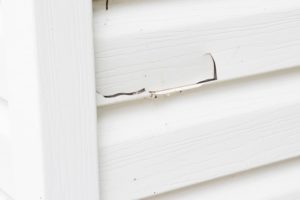As a Midwesterner, you’re more than familiar with the bursts of hail that come out of nowhere throughout the year. Hail can strike anytime during thunderstorms in the spring, summer, and fall months, but most storms happen from May through September. Therefore, a drop in temperatures during this time is a good indicator of a potential hailstorm. Depending on the size of hail, hailstorms can cause significant damage to your car windshield or roof, but siding damage can also occur. Cracks, holes, and concealed water damage may require siding storm damage repairs or a total siding replacement.
How does hail damage a home?
When warm and cold fronts meet during a storm, raindrops are carried by rising updrafts into the cold atmosphere, turning them into hailstones. The hail drops once they are large enough that the updraft cannot support its weight. Hailstorms can cause extreme damage to humans, animals, homes, and cars. In fact, hail damage is one of the most common homeowners’ insurance claims filed each year in the United States. There’s a pretty high chance that some kind of damage will happen, even with hail particles of much smaller sizes falling. High-quality residential roofing helps protect your home’s siding and windows from adverse weather, but hailstorms can still be highly destructive.
Is my siding susceptible to hailstorm damage?
Modern siding materials such as stone, engineered wood, and vinyl siding are incredibly durable but can still be damaged during hailstorms without the proper installation or quality of care. When considering a new siding installation, keep the following few things in mind to minimize susceptibility to hailstorm damage:
- Installation – Proper installation can protect your home’s siding from more severe issues after hailstorms. Have a professional siding installation company complete the job to ensure it’s done correctly and can withstand harsh weather like hail.
- Age – All siding materials will eventually fail due to old age. Although the average lifespan of vinyl siding is a staggering 20 to 40 years, with proper care and maintenance, you still might need to replace your siding after buying an older home to avoid hail damage.
- Environment – Where you live will also impact the longevity of your home’s siding. For example, homeowners residing in environments where hailstorms, heavy rain, snow, or strong winds are common may experience more siding issues.
- Quality – The quality of your siding can also determine its durability during hailstorms. Well-recognized brand names in the construction industry often come with warranties or guarantees that their siding products are built to last.
- Level of Care – Taking care of your siding is crucial. Annual maintenance is essential for minimizing the impacts of storm damage on your home’s siding. Clean your siding regularly and evaluate it for any issues, which should be dealt with by a professional siding company right away.
Looking for damage
At first, you may not notice any damage to your siding. This is because hail damage, or any exterior storm damage, can be invisible to the untrained eye. If you are unsure whether or not hail or wind has affected your siding, you can take a look around the perimeter of your home. It is best to do this during early evening or midday when the sun won’t be so bright that it casts shadows on the house, and when there is still enough light to get a good glimpse.
Common hailstorm damage to siding
Cracking
Blowing debris like sticks and tree limbs or powerful winds can most commonly create cracks in the siding. The heavy hail can also break through even the best siding materials. Networks of cracks in your home’s siding materials might range from minor to significant damage, potentially requiring the replacement of an entire siding panel at times.
Vinyl siding is very popular for homeowners in environments where hailstorms and other harsh weather conditions are expected. Since vinyl siding systems are made up of individual slats, removing and replacing cracked and broken siding panels is a simple process. Very seldom will homeowners have to replace the entirety of vinyl siding on their house, even after extensive hailstorm damage.
Chipping
Chipped siding is another sign of damage often found after a furious hailstorm. Typically, the underside of vinyl siding will chip away over time, thanks to the impacts of the balls of ice.
Water Damage
Another common problem homeowners face with siding is water damage. Although hail itself isn’t responsible for the water damage, the precipitation that comes along with hailstorms can have a detrimental effect on poorly installed siding.
Rainwater easily seeps into improperly installed siding that lacks an adequate insulating barrier behind the panels. The lingering precipitation can cause irreparable damage to the siding, requiring a total siding replacement. Some common signs of water damage to watch out for after a hailstorm include:
- Mold or mildew
- Discoloration
- Water stains
- Warping panels
- Bubbling
- Peeling interior paint or wallpaper
- Fungus growth
Water damage is one of the worst problems for property owners because it isn’t always immediately apparent. Working with a reputable siding company ensures a high level of expertise for installations and repairs, helping homeowners avoid further water damage in the future.
Dealing with the damage
With a reliable storm damage repair company on your side, dealing with siding damage from hailstorms doesn’t have to be a huge hassle. Next time you need storm damage restoration for your home’s siding after a hailstorm, have the experts at HomeWise Roofing & Exteriors take a look. Contact us today to schedule a storm restoration consultation and deal with any siding damage after hailstorms.





